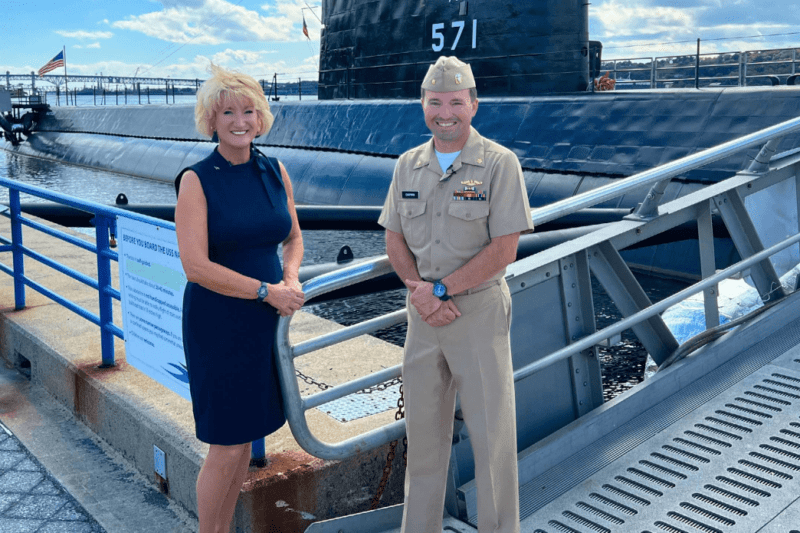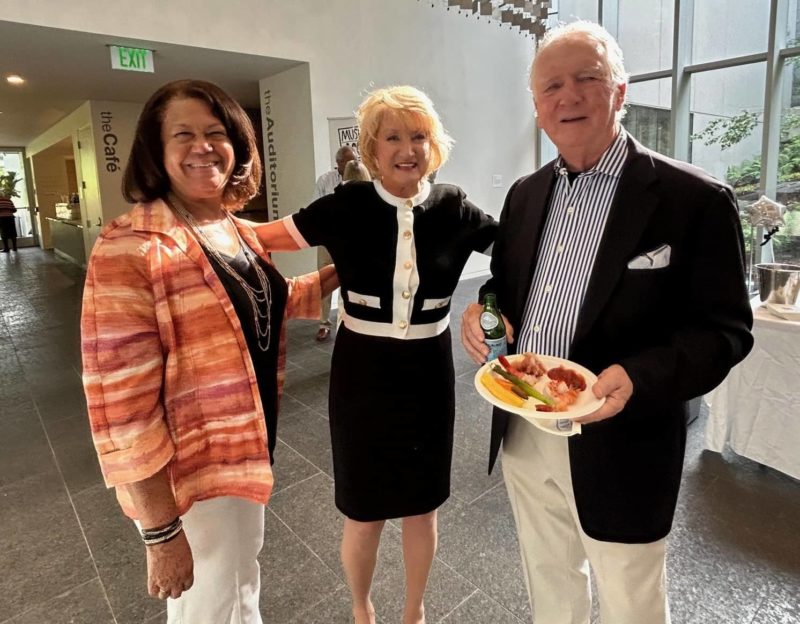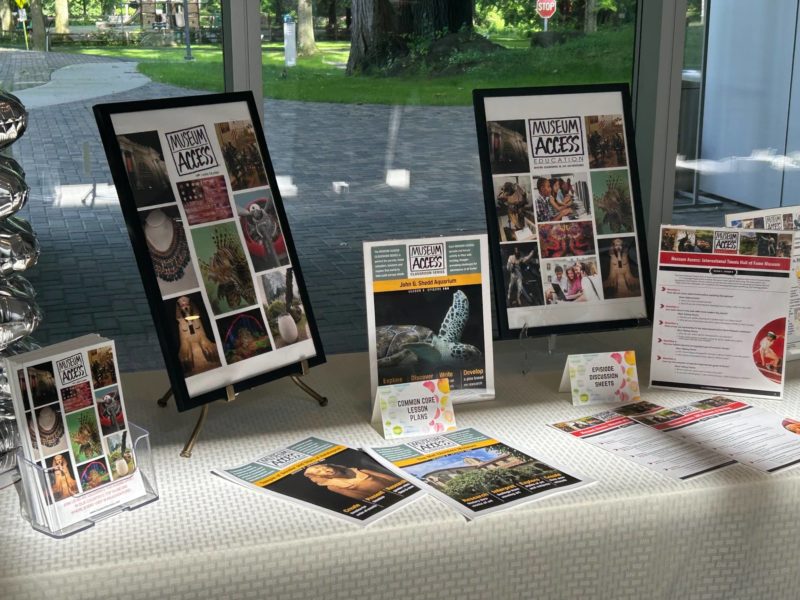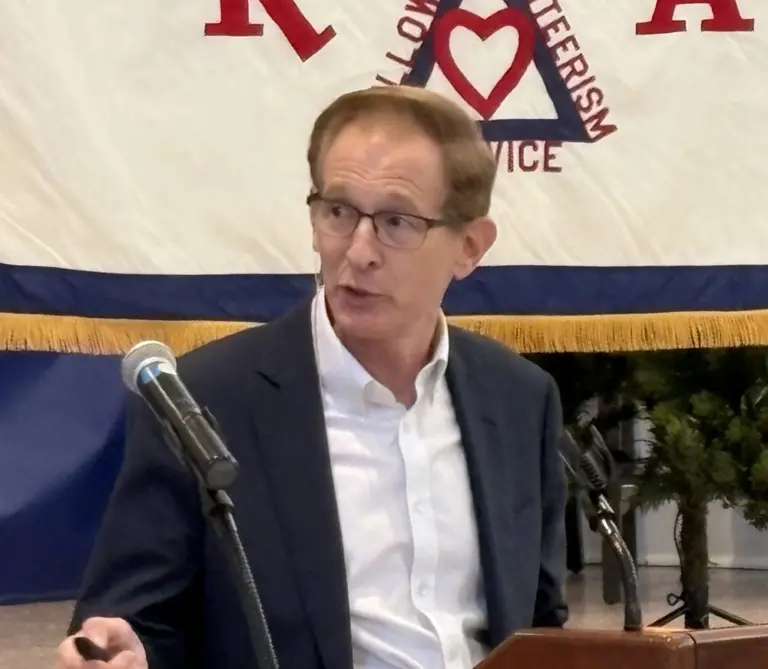
By Anne W. Semmes
If there was an ambassador of museums in this country, it would be Leslie Mueller, creator and producer of the TV series, “Museum Access” shown on public television, now in its sixth year of profiling another ten museums – yes, a total now of 60 museums. Last Thursday evening at the Bruce Museum, Mueller shared glimpses with guests and supporters of her Season Six, that includes two museums in Greenwich, the new Bruce and the Bush-Holley House, that birthplace of American Impressionism.
But it was Mueller’s behind the scenes experiences in those museums across the years that radiated. So, Chicago features large in Mueller’s life, having grown up there, visiting museums on class field trips. “They were the most magical places I had ever seen,” she said.
So, at age 13 her parents enrolled her in art classes at the Art Institute of Chicago, and “that experience changed my life direction,” she said, and that direction became Museum Access.
At another Chicago museum she would feature, the Adler Planetarium, she met Jim Lovell, the first of three astronauts to fly on Apollo 13 to and orbit the moon in 1968. “Jim Lovell was a big part of the exhibition there…they have a statue of him where he’s holding his thumb up.” Mueller planned a 20-minute talk with him, but she ended up visiting Lovell at his home in Lake Forest. “It was the most fascinating conversation I’ve ever had,” she said. He’d described his formative moment of having a book that showed him how to make a bottle rocket. “He and his buddy at age 13 went behind the gas station and set off this bottle rocket that soared 40 feet up in the air. And he said, ‘That’s what I want to do. I want to be up in the air.’”
Those formative art classes in Mueller’s youth had her going behind the scenes – always a segment of each show – again to that Art Institute of Chicago she was featuring. She’d learned that a favorite painting of her youth by Georges Seurat was undergoing a rare reframing. So, “We talked with the guy in the restoration area who was in charge of framing – everybody in the art world was up in arms…They did a lot of studying and they realized he actually framed it in his own studio – it was a plain white frame, which is what they ended up doing.” She had learned in depth, “There’s a lot of research that goes on at these museums.”
This behind the scenes approach also played out featuring the International Museum of Surgical Science in Chicago although “their entire collection was on view.” So, “We decided to focus on the technology of X-rays… And you can see one of the first x-rays taken was of a mummy.” So, what if she could visit the radiology department in a nearby hospital to learn how helpful x-rays are. A neurologist would invite her to witness a woman having a brain procedure. “She was more than happy to let us shoot it. So, we’re sitting there on the other side of the glass and the surgeon isn’t even looking at her. He’s looking at the screens and he’s guiding his instruments, based on what he was seeing on the screen.”
Mueller was no doubt led to the American Heritage Museum in Massachusetts by her father who flew B17’s in World War II. “They were sponsoring a Wings of Freedom tour that was coming through Connecticut,” she said, “And I was going to have the opportunity to actually fly in one of those planes that they had. So, we boarded and went over Long Island Sound, and all I can tell you is that my videographer kept saying to me, ‘Stop, squealing, stop!”

Another family figured in her visit to the Harley Davidson Museum in Milwaukee, Wisconsin. “My grandfather had actually worked at the Harley Davidson factory after World War I,” she said, and thought she should go. “God’s telling me something…I’m talking to Bill Davidson and telling him this story and he said, ‘It was not uncommon for young men from Milwaukee to come back from World War I. We employed most of them… After we finished shooting that day, he took me into this area where they had a huge rack…and he says, see that top row of motorcycles, your grandfather’s hand was on every one of those.”
Mueller would take attendees to the Mystic Museum where the Mayflower II ship was undergoing renovation before returning to Plymouth, Massachusetts, then to the “absolutely breathtaking” Ringling Museum in Sarasota, Florida. Then return us to the new Bruce in all its splendor where some American Impressionist paintings were are on view.
She is motivated to “introduce viewers to the magic that happens behind those great doors of the museums,” she said. She is aware, “that many people would never get to go visit the museums that I had the opportunity to go to…So let’s bring the museums to them so we make museums accessible to everyone.”
Mueller’s mission statement is impressive. It reads, “We live at the intersection of entertainment, education, and inspiration. We believe in the power of museums to ignite the imagination and inspire learning by all, by opening their doors to all regardless of age, income, ethnicity or geographic location. Our mission is to increase learning and increase the appreciation of these national treasures we call museums through our series.” And she notes there are 35,000 museums within the United States, so she continues to have a wealth to choose from.
Mueller has also embraced offering an education extension. When Covid hit, ‘We started pulling together information sheets that teachers and parents could use.” A coloring book is “very popular. We took pictures from museums…and there’s word games.” Add engaging seniors in “conversation sheets…the idea is that you watch an episode and then you have a conversation about it.”
Count also the US Department of Education’s Described and Captioned Media Program, DCMP. “So, we offer closed captions and video, and have described all of our content for K through 12, blind or partially deaf students…These kids are like, ‘There was nothing I could watch. Now I want to watch more.’”
Now just how do we find Museum Access on our TVs? “Every single area is different and each station is different,” she tells. “In our area, CPTV handles our show and WLIW in New York, which we can also get here…You have to check for local times and listings because they vary. For more information visit https://museumaccess.com







